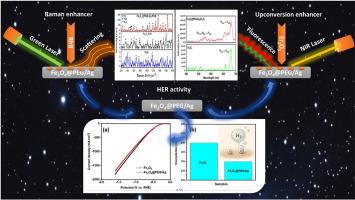Fe3O4@PEG/Ag纳米复合材料与提高HER活性的拉曼和上转换光谱为基础的双模增强
IF 4.6
3区 工程技术
Q2 ENGINEERING, ELECTRICAL & ELECTRONIC
引用次数: 0
摘要
由于散射和非线性光学效应,拉曼光谱和上转换光谱信号本身就很弱。为了增强拉曼光谱和上转换光谱信号,银(Ag)纳米复合材料由于其通过表面等离子体共振(SPR)更好的协同增强策略而受到需求。合成了Fe3O4@PEG/Ag纳米复合材料,并利用x射线衍射(XRD)、傅里叶变换红外光谱(FTIR)、紫外可见、场发射扫描电镜(FESEM)、能量色散x射线光谱(EDS)、Zeta电位、荧光显微镜和拉曼光谱对其进行了表征。Fe3O4@PEG/Ag纳米复合基衬底分别探测RhB和Er2O3,显示出双模拉曼和上转换增强能力。在532 nm绿色激光照射下,利用表面增强拉曼散射(SERS)对RhB在~ 1660 cm−1处的特征峰进行了拉曼增强研究。然而,在上转换发射研究中,在980 nm近红外激光二极管激发下,通过多光子吸收检测到改进的Er3+离子跃迁。有趣的是,在绿色激光激发下,由于980 nm近红外激光光子与Fe3O4@PEG/Ag纳米复合材料中Ag离子的表面等离子体共振相互作用的非线性光学效应,产生了低荧光背景的SERS,并提高了上转换,从而实现了信号强度的放大。与Fe3O4相比,Fe3O4@PEG/Ag的HER活性得到了提高,过电位值(230 mV)更低。实验研究表明,合成的Fe3O4@PEG/Ag纳米复合材料具有更高的HER活性,可能适用于下一代基于拉曼和上转换光谱的双模增强器。本文章由计算机程序翻译,如有差异,请以英文原文为准。

Fe3O4@PEG/Ag nanocomposite with improved HER activity for Raman and upconversion spectroscopy-based dual-mode enhancer
Raman and upconversion spectroscopy signals are inherently weak due to scattering and nonlinear optical effects. To enhance Raman and upconversion spectroscopy signals, silver (Ag) incorporated nanocomposites are currently in demand due to their better synergistic enhancement strategies through surface plasmon resonance (SPR). Fe3O4@PEG/Ag nanocomposite has been synthesized and characterized by using X-ray diffraction (XRD), Fourier Transform Infrared Spectroscopy (FTIR), UV–visible, Field Emission Scanning Electron Microscopy (FESEM), Energy dispersive X-ray spectroscopy (EDS), Zeta potential, Fluorescence microscopy, and Raman spectroscopy. Fe3O4@PEG/Ag nanocomposite-based substrate shows dual-mode Raman and upconversion enhancer capability by probing RhB and Er2O3, respectively. Raman enhancer study has been done by monitoring the RhB characteristic peak at ∼1660 cm−1 and explained on the basis of surface-enhanced Raman scattering (SERS) under a 532 nm green laser irradiation. Whereas, in the upconversion emission study, an improved Er3+ ion transition is detected under 980 nm NIR laser diode excitation via multiphoton absorption. Interestingly, amplification of the signal intensity has been achieved, as SERS with low fluorescence background under green laser excitation and improved upconversion arise from the nonlinear optical effects due to the interaction of 980 nm NIR laser photons with the surface plasmon resonance of Ag ions available in the Fe3O4@PEG/Ag nanocomposite. Improved HER activity of Fe3O4@PEG/Ag with a lower overpotential value (230 mV) as compared to Fe3O4 has been obtained by electrocatalytic performance. Experimental studies carried out in this work show that the synthesized Fe3O4@PEG/Ag nanocomposite with improved HER activity may be suitable for next-generation Raman and upconversion spectroscopy-based dual-mode enhancer.
求助全文
通过发布文献求助,成功后即可免费获取论文全文。
去求助
来源期刊

Materials Science in Semiconductor Processing
工程技术-材料科学:综合
CiteScore
8.00
自引率
4.90%
发文量
780
审稿时长
42 days
期刊介绍:
Materials Science in Semiconductor Processing provides a unique forum for the discussion of novel processing, applications and theoretical studies of functional materials and devices for (opto)electronics, sensors, detectors, biotechnology and green energy.
Each issue will aim to provide a snapshot of current insights, new achievements, breakthroughs and future trends in such diverse fields as microelectronics, energy conversion and storage, communications, biotechnology, (photo)catalysis, nano- and thin-film technology, hybrid and composite materials, chemical processing, vapor-phase deposition, device fabrication, and modelling, which are the backbone of advanced semiconductor processing and applications.
Coverage will include: advanced lithography for submicron devices; etching and related topics; ion implantation; damage evolution and related issues; plasma and thermal CVD; rapid thermal processing; advanced metallization and interconnect schemes; thin dielectric layers, oxidation; sol-gel processing; chemical bath and (electro)chemical deposition; compound semiconductor processing; new non-oxide materials and their applications; (macro)molecular and hybrid materials; molecular dynamics, ab-initio methods, Monte Carlo, etc.; new materials and processes for discrete and integrated circuits; magnetic materials and spintronics; heterostructures and quantum devices; engineering of the electrical and optical properties of semiconductors; crystal growth mechanisms; reliability, defect density, intrinsic impurities and defects.
 求助内容:
求助内容: 应助结果提醒方式:
应助结果提醒方式:


